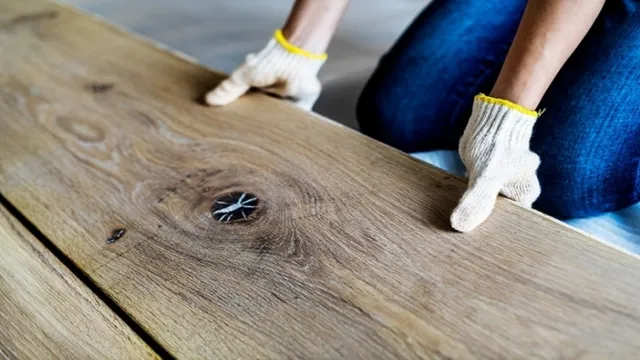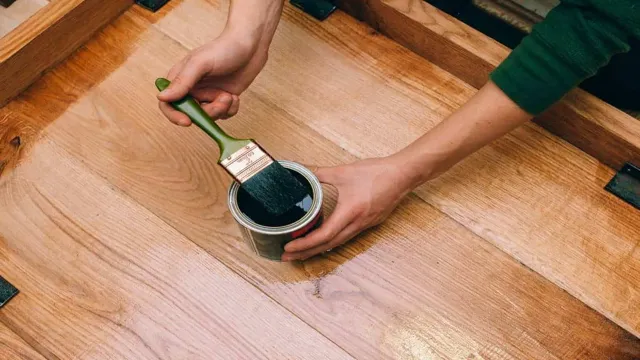Have you recently completed a woodworking project and noticed that the freshly cut wood is already displaying signs of decay and rot? If so, it’s not uncommon to feel frustrated and discouraged after all the time and effort you’ve put into your project. But before you throw in the towel, have you considered using a wood hardener on your new wood? A wood hardener is designed to penetrate and strengthen soft, rotting wood fibers, but as with any solution, there are pros and cons to consider. In this blog, we’ll dive deeper into the benefits and drawbacks of using a wood hardener on new wood, so you can make an informed decision on whether it’s the right choice for your project.
So sit back, grab a cup of coffee, and let’s get started!
What is Wood Hardener?
Wood hardener can be a valuable tool in restoring and preserving old or damaged wood. But can it be used on new wood? The answer is yes, but it may not be necessary. Wood hardeners work by penetrating the wood fibers and strengthening them, but new wood is already strong and stable.
However, if the new wood is exposed to elements that may cause damage or rot, such as rain or insects, applying wood hardener can provide an extra layer of protection. Additionally, if the new wood is being used for a project that requires extra durability, such as a deck or outdoor furniture, wood hardener can be applied to increase its longevity. Overall, while wood hardener is not essential for new wood, it can be a beneficial preventive measure in certain circumstances.
Explanation of Wood Hardener
Wood hardener is a liquid solution that works as a sealant and consolidant for damaged or decaying wood. It is used to strengthen wood by penetrating deep into the fibers and filling the gaps that are caused by decay or woodworm. The chemical composition of wood hardener varies depending on the brand, but it typically contains a combination of solvents and resins that work together to make the wood more resilient.
Wood hardener is an excellent solution for preserving and restoring old furniture, decking, fences, and other outdoor woodwork. It helps to prevent further damage by sealing the wood surface and making it waterproof. Using wood hardener is an important step in the restoration process, preventing wood from further decay and ultimately extending the life of woodwork.
So if you have a wooden object that has seen better days, try using a wood hardener to bring it back to life.

Can Wood Hardener be Used on New Wood?
Many people wonder if wood hardener can be used on new wood. The answer is yes, wood hardener can certainly be used on new wood. In fact, it is often recommended to use wood hardener on new wood to ensure that it is properly protected and strengthened.
When wood is new, it is often softer and more vulnerable to damage. By applying a wood hardener, you can make the wood more durable and resistant to moisture, rot, and insect damage. It can also help to prevent warping and splitting.
Applying a wood hardener to new wood is a proactive measure that can help to prolong the life of the wood and keep it looking great for longer. Whether you are working on a DIY project or making major repairs to your home, using a wood hardener on new wood is a smart decision to make.
Factors to Consider
When it comes to using wood hardener on new wood, there are many factors to consider. First of all, it’s important to determine what kind of wood you’re working with. Some woods may absorb the hardener more readily than others, so it’s important to choose a product that’s appropriate for the type of wood you’re using.
Additionally, you’ll want to consider the project you’re working on. If you’re building something that’s meant to last for a long time, using a wood hardener can help to ensure that the wood is as strong and durable as possible. However, if you’re working on a project that’s meant to be more temporary, the added expense and time of using a wood hardener may not be worth it.
Ultimately, it’s up to you to determine whether or not using a wood hardener on new wood is the right choice for your project.
Pros and Cons of Using Wood Hardener on New Wood
Yes, wood hardener can be used on new wood, but there are both pros and cons to consider before doing so. On the plus side, treating new wood with a hardener can help to prevent future rot and decay, as well as make the wood stronger overall. This can be particularly helpful if the wood will be exposed to the elements, as it will be better able to withstand the effects of sun, rain, and wind.
However, there are also some potential downsides to using a hardener on new wood. For one thing, it can be expensive, especially if you need to treat a large amount of wood. Additionally, some types of wood may not be suitable for hardening, as they may be too porous or contain too much moisture.
Finally, the hardener may not provide a perfect solution, and there may still be some risk of rot or decay over time, especially if the wood is exposed to particularly harsh conditions. Ultimately, whether or not to use a wood hardener on new wood will depend on a variety of factors, including the type of wood, its intended use, and your budget and preferences.
How to Apply Wood Hardener on New Wood
Yes, wood hardener can be used on new wood to prevent any future damages. Wood hardener works by penetrating the wood pores and sealing them while also strengthening the fibers of the wood. Before applying the wood hardener, it’s important to ensure that the wood is clean and free of any dirt, dust, or debris.
Sanding the wooden surface will help to open up the pores of the wood and allow the hardener to penetrate more deeply. Once the preparation process is complete, apply the wood hardener using a brush or a spray, depending on the type of wood hardener used. It’s important to let the wood hardener dry completely, which could take several hours or even a day or two depending on the wood type and environmental conditions.
Once the wood hardener is dry, sand the surface again before applying any finish to ensure a smooth and even finish. With the right preparation and application, using wood hardener on new wood can prolong its lifespan and prevent future damages.
Step-by-Step Guide
Wood hardener is a crucial component to ensure the longevity and durability of new wood. Applying wood hardener on new wood is a straightforward process that requires a few tools and materials. Firstly, ensure that the wood surface is neat and clean by sweeping or blowing any debris or sawdust.
Then, use a paintbrush or spray can to apply the wood hardener evenly on the surface and let it soak in for a few minutes. Wipe off any excess wood hardener and leave it to dry for at least six hours. It’s crucial to wear gloves and a respirator during the process as the wood hardener contains harmful chemicals.
Once the surface is dry, you can sand the wood to make it smoother. By applying wood hardener, it will resist moisture and prevent rotting, making it a necessary step for new wood.
Conclusion
In conclusion, while wood hardener can certainly be used on new wood, it’s like using an anti-aging cream on a toddler’s face. Sure, it technically works, but why bother when the wood is already strong and resilient? Save the wood hardener for those weathered, worn-down pieces that need a little extra love and attention. After all, we should prioritize our efforts and resources where they will make the most impact.
That’s just good common sense, and with a dash of wit, we might add.”
Final Thoughts on Using Wood Hardener on New Wood
Applying wood hardener on new wood is a great way to protect it against decay, insects, and other types of damage. However, it’s important to use the right techniques to ensure that the wood hardener is applied effectively. First, make sure to clean and dry the new wood thoroughly before applying the wood hardener.
Then, use a brush or spray to apply the wood hardener evenly to the entire surface of the wood. Be sure to follow the manufacturer’s instructions carefully, including the recommended drying time and number of coats. By using wood hardener on new wood, you can ensure that your project will last longer and look better over time.
FAQs
What is a wood hardener and how does it work?
Wood hardener is a liquid that penetrates and strengthens decaying wood fibers, making them more solid and resistant to further damage. It works by reacting with the cellulose in the wood and forming a strong bond with the wood fibers.
Is it necessary to use wood hardener on new wood?
No, it is not necessary to use wood hardener on new wood as it is already strong and in good condition. Wood hardener is usually used on decaying or rotting wood that needs to be strengthened or preserved.
Can you apply wood hardener on painted or finished wood surfaces?
No, you cannot apply wood hardener on painted or finished wood surfaces as it requires direct contact with bare wood fibers for proper penetration and bonding. It is recommended to remove any paint or finish before applying wood hardener.
How long does it take for wood hardener to dry and cure?
The drying and curing time of wood hardener varies depending on the temperature and humidity of the environment. Generally, it takes 24-48 hours to dry and cure completely.
Can wood hardener be used on outdoor wood structures like decks and fences?
Yes, wood hardener can be used on outdoor wood structures like decks and fences to strengthen and preserve them against weather and decay. However, it is recommended to also apply a waterproof sealant over the wood hardener for added protection.
Do you need to sand the wood after applying wood hardener?
No, sanding the wood after applying wood hardener is not necessary unless you want to smooth out any rough or uneven spots. Wood hardener dries clear and can be painted or stained over after it has cured.
Can wood hardener be used on all types of wood?
Wood hardener can be used on most types of wood, including softwoods, hardwoods, and even plywood. However, it is important to test a small area first to ensure that the wood does not have a reaction or discoloration with the wood hardener.






